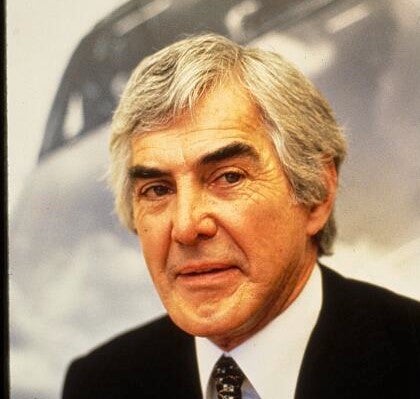The automobile industry makes more than cars; over its history, car companies have shaped society. People in the upper ranks of these companies have always been good at making headlines, but none were better than John DeLorean.
In his time, people believed DeLorean to be nothing more than a walking controversy, but most today value him as a trailblazer so committed to success that he was willing to do anything to achieve it.
According to his autobiography, John DeLorean grew up in Detroit, Michigan and was surrounded by the automotive industry.
Everyone around him growing up, including his parents, were employed by one of the “Big Three” domestic automotive manufacturers. He was a studious young man and was drawn to the engineering side of the business.
MORE: Racing group holds final Hall of Fame banquet
Before landing an engineering job at Chrysler, DeLorean sold insurance and was extremely successful, but unhappy with the job. At Chrysler, he would hone his salesman skills that would make him successful later in life.
After working less than a year at Chrysler, he was given an offer to join the engineering team at Packard. DeLorean climbed his way up to head of research and development in that company.
Unfortunately, DeLorean admits in his autobiography that not even John DeLorean could save Packard, which was bleeding money and market share in their turf war with General Motors and Ford. He then decided to take a job offer with his competitor, General Motors, which came with a huge pay increase and his choice of division to work with.
DeLorean picked Pontiac, which was going through a bit of a rough patch. According to an article in Autoweek, it was jokingly called “the grandma division” by insiders, the cars were boring, and sales were down. DeLorean wanted the division to have a reputation for power and broke all the rules in doing so.
In 1964, the Pontiac GTO was born despite the current leadership of GM. With the success of the GTO, he was put in charge of the entire division, becoming the youngest person to do this in GM history to this day according to the book, Dream Maker: The Rise and Fall of John Z. DeLorean by Ivan Fallon, James Srodes.
It is important to understand what type of man John DeLorean was to understand his story. This man was connected to popular culture in a way that no one else in the industry had ever been. DeLorean’s co-workers wore stodgy suits and played golf, while he showed up to meetings with butterfly-collared shirts half buttoned as noted in the documentary “Myth and Mogul”. He married supermodels, held celebrity filled parties and became like a Warren Beatty character who just happened to sell cars.
American celebrity culture embraced DeLorean and he was friends with Johnny Carson and Sammy Davis Jr, who would later be big investors in DeLorean’s namesake car company according to Srodes and Fallon.
While breaking the corporate molds with his audacity, DeLorean’s Pontiac also broke sales records.Pontiacs had achieved the image of being the cool car to drive. DeLorean’s team released cars that were wide, low to the ground, packed with horsepower and had styling that was totally distinct from other GM offerings.
MORE: Motorheadline: When it comes to cars, it’s best to shop locally
John DeLorean was successful in unconventional ways, but he disliked being a corporate executive, as stated in the documentary “Framing John Delorean”. He didn’t belong and his fellow executives reminded him of that constantly.
The goals and direction of GM were beginning to go outside the comfort zone of DeLorean, relationships became strained, and things were quickly coming to an end.
DeLorean didn’t want to make normalcy, he wanted to shine. He built excitement, speed, and excess which were ill suited for any domestic car manufacturer at that time. In 1973, he parted ways permanently with GM, leaving behind a large salary, but also the restrictive rules of an overseeing corporation that seemed more concerned with money than making a quality product.
DeLorean’s departure is widely considered to be the onset of the “Malaise Era” in American automobile manufacturing.
When he walked out, DeLorean left with nothing more than a folder of drawings he was working on. It was for a car he knew GM would never make.
In 1975, DeLorean Motor Company was created with only one car on the drawing board. The DMC-12 was a very ambitious car at the time, especially coming from a new car company.
The $200 million price tag for production startup also was a problem. Although DeLorean was great at raising money and building excitement, the sheer cost of starting an entire car company outweighed his skills alone. He needed help, according to Srodes and Fallon.
Corporations all over the world have relied on tax breaks and government funding for centuries, so DeLorean decided to do the same. Governments in tough times need businesses to provide work to their citizens.
An arrangement with the government of the United Kingdom was sought to build the DMC-12 plant in Northern Ireland at the tune of about $120 million, with the thought of providing jobs that would reduce the violence and infighting in the area.
The biggest problem with this was that the area was filled with unskilled workers with no industrial background. It was at this time that John DeLorean started to make undeliverable promises and take part in less than savory business partnerships.
MORE: MotorHeadline: Automotive enthusiasts must start somewhere
Shell companies, outright lies, and offshore bank accounts became the norm to cover up for the financial trouble the DeLorean company was in. However, cars were being made and deliveries were starting to take place.
For a short time, the company was profitable, and everything looked to be going as planned.
The DMC-12 was a fantastic car on paper. The stainless-steel exterior was rustproof and eternal, and the styling was a breath of fresh air in a time when bigger and boxy was better. The gull wing doors were futuristic and stylish. It was a vision that screamed into the new decade and set a tone for an entire new generation of car owners.
In reality, the car was less than desirable. In fact, it was terrible.
Car and Driver magazine wrote, “this is unquestionably the most ambitious attempt at running-before-walking ever seen in the variegated history of the auto industry.”
While the industry had high hopes for such a huge undertaking of a new car company, the 131 horsepower V6 engine pulled from the Renault parts bin was not exactly a rocket and the 10.5 second 0-60 mph time was behind the curve, even for the 1980s.
The DMC-12 also got an unimpressive 19 miles to the gallon, which made it uneconomical as well. The stainless-steel exterior was difficult to clean and showed unsightly fingerprints.
The car would be plagued with build quality, fitment issues, electrical gremlins, and doors that may or may not open when requested. It was a “sheep in wolf’s clothing” if there ever was one. It was shunned in Motor Trend, which is never a good thing for an automotive start up.
The DMC-12 was John DeLorean’s first and biggest flop, but it wouldn’t be his biggest mistake.
By 1982, most of the quality issues were ironed out, but with only 6,000 units sold, DMC was in trouble. The break-even point for investors was the 12,000 unit mark, and there was no more money available to get to that production number.
DeLorean asked again for help from the British Government to bolster his coffers but met with resistance. The British Government would possibly match other investors but would offer no more corporate aid than what the company had already received.
MORE: MotorHeadline: Interstate love song
DMC needed money, and DeLorean was determined to find a way to get it. He was a well-connected person, but he didn’t have to go far to find his solution.
Then it happened, DeLorean’s next-door neighbor, Jim Hoffman, contacted DeLorean to offer him a chance to get in on a cocaine smuggling opportunity. Hoffman was a paid FBI informant that was caught trafficking drugs before and turned informant to reduce the consequences of his actions.
Hoffman knew DeLorean was desperate for cash and used him to appease his handlers.
The year1982 was the beginning of the “War on Drugs” and the Federal Government was more than happy to tie someone as prominent as DeLorean to trafficking to use as an example.
Desperation for his company to stay afloat clouded his judgment and ultimately ruined everything he worked for.
Eventually, DeLorean was found not guilty, but not because he was innocent.
The U.S. government was basing their entire case off of entrapping a desperate man to do something he would not normally do. He was a free man, but his life, company, and even his family was ruined forever. No one would dare touch anything involving DeLorean again.
A victim of his own ambition, DeLorean faded into obscurity. Facing bankruptcy from lawsuits, the New York Post reported that he sold his 434-acre Bedminster Estate in New Jersey to Donald Trump, who built a golf course there in 2002.
He moved to a one-bedroom condominium and lived out his days planning his comeback, until a stroke ended his life in early 2005.
Incredibly, the story of the DMC-12 and DeLorean Motor Company is still being created.
The popularity of the DMC-12, cemented by the “Back to the Future” movie franchise, has increased over the years. Restored DMC-12 models now fetch over $30,000 on average and enthusiast groups have car shows and message boards discussing repairs and trading parts to complete their builds.
There is even an electric vehicle, the DeLorean Alpha, that will be coming to market soon as reported by the new DeLorean Motor Company website. Let’s just hope the electric gullwing doors work this time.
History may not remember John DeLorean fondly, but the car community should be thankful people like him demanded and provided greatness in their chosen craft.
See you on the road!
Taylor Bryant is an automotives instructor for Augusta Technical College.













